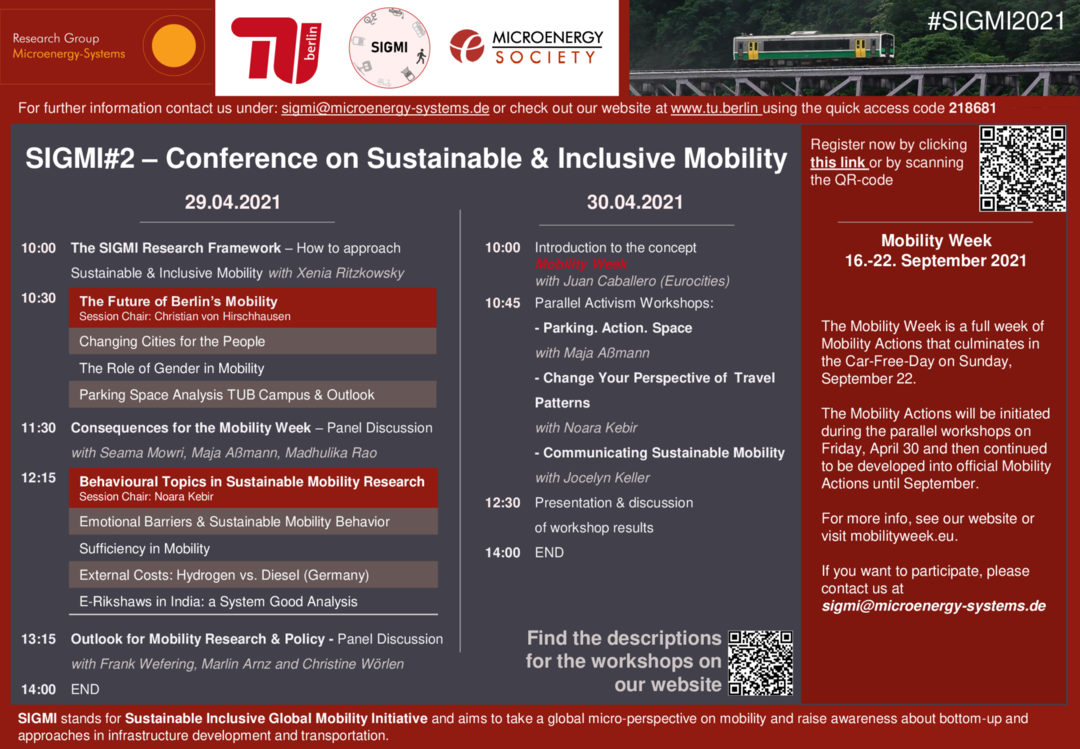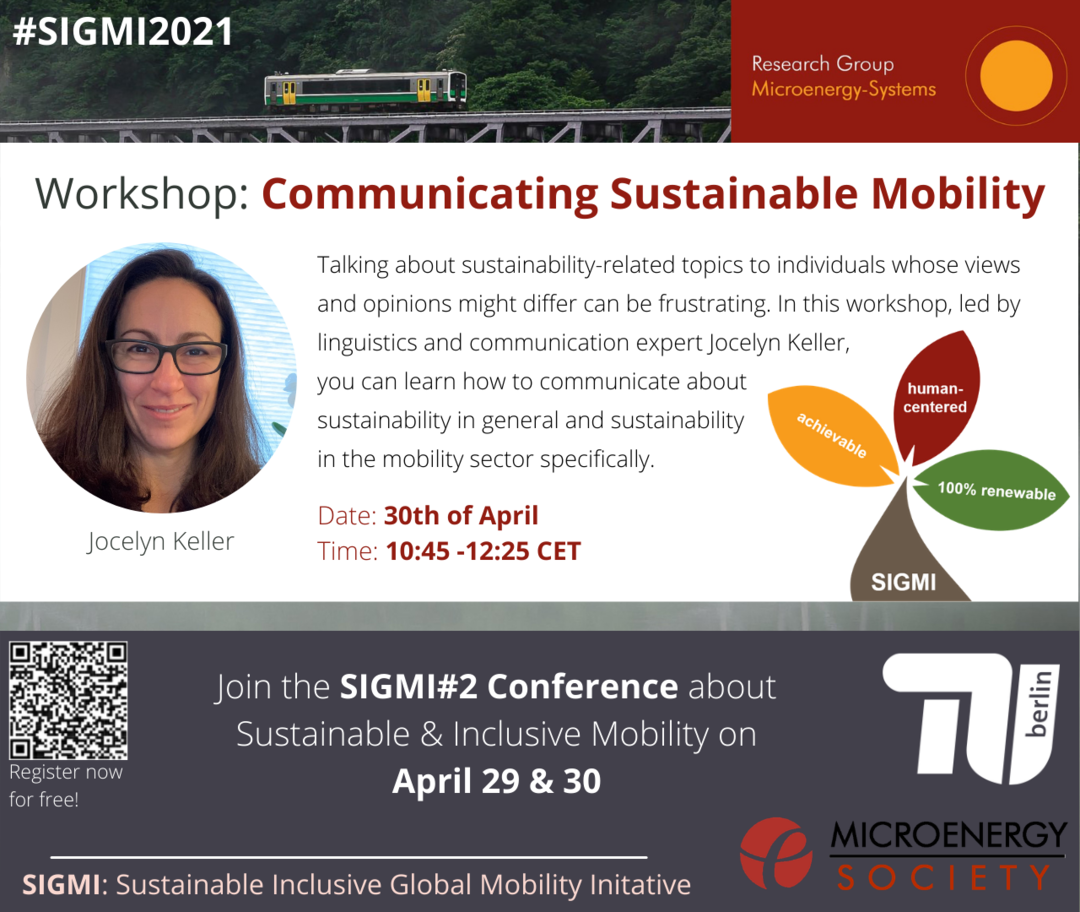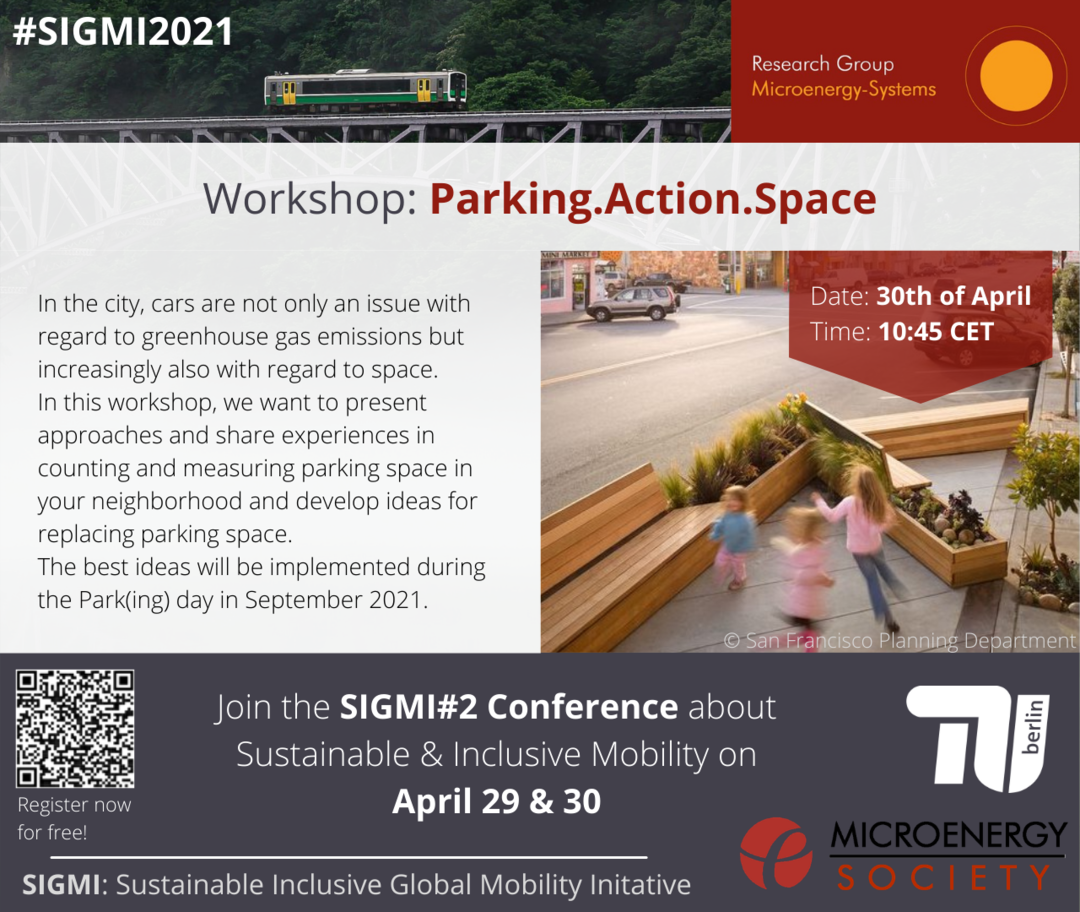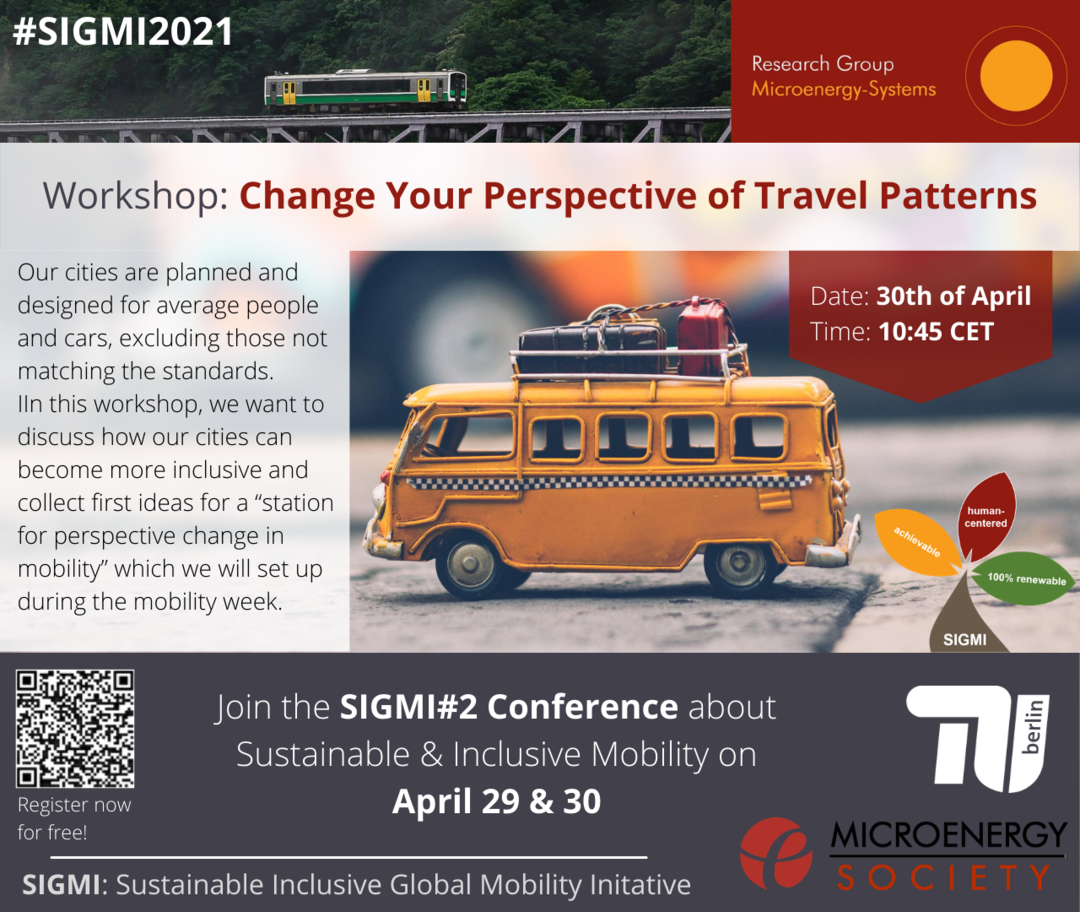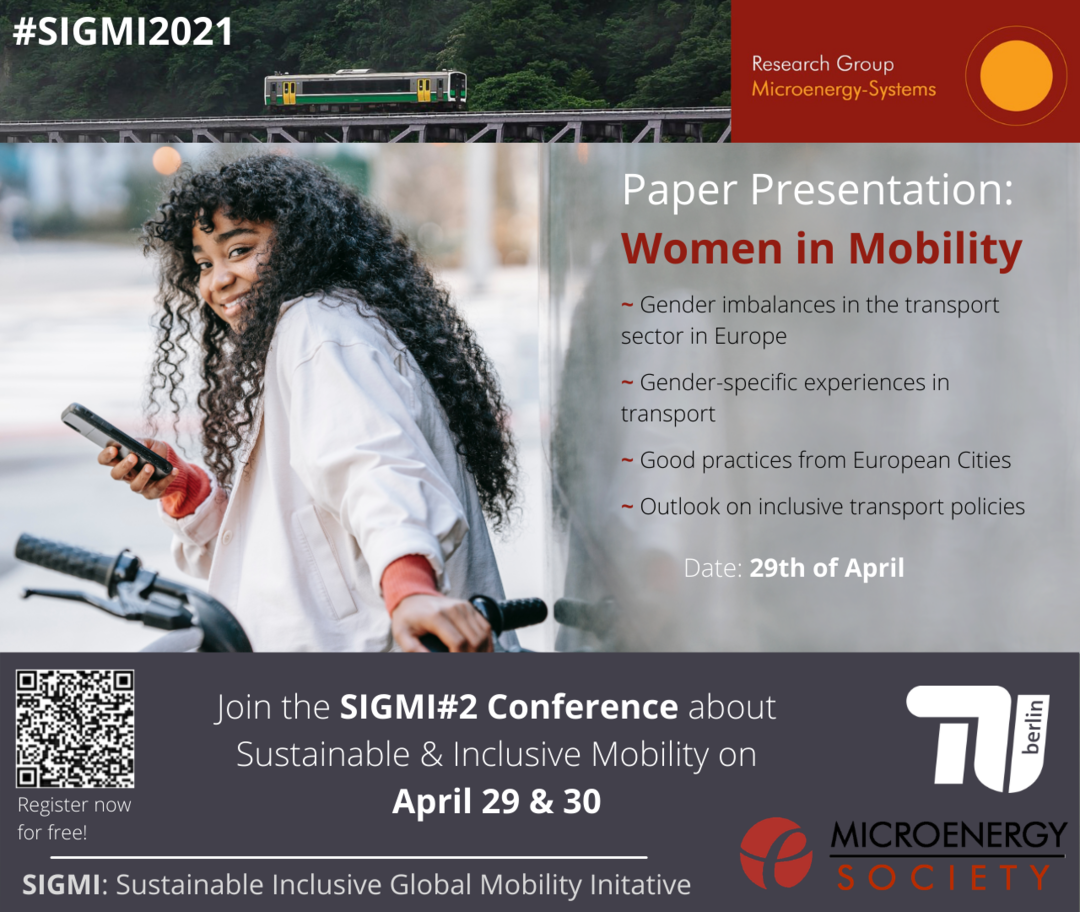The SIGMI#2 Conference
On April 29th and 30th the SIGMI will go in a second round! After our successful conference in November 2020 we want to continue and offer a second free event.
During the event you can look forward to keynotes and discussions by mobility experts and dive into research presentations that were developed after the first conference.
Also, the second day, April 30th, the activism around this years Mobility Week will be the focus of the conference.
To learn more about sustainable mobility, please check out the video recordings of the 2020 SIGMI Conference on our YouTube channel. Please note, we are still uploading more videos in the following days.
The conference program is set and to be found below.
To keep up to date and receive sneak peaks of the event follow us on Instagram, LinkedIn or Twitter.
The SIGMI - Introduction
The Sustainable and Inclusive Global Mobility Initiative (SIGMI) aims to take a global micro-perspective on mobility and raise awareness about bottom-up and human-centric approaches in infrastructure development and transportation.
The background paper on the SIGMI Sustainable & Inclusive Mobility Framework by Xenia Ritzkowsky is available here for download.
Learn more about the SIGMI - just click here.
One of the major focal points of this conference will be the Mobility Week (September 2021), so feel free to learn more about this mobility action week. During the event you have the chance to create your mobility action in one of the activism workshops.
Conference Program
Here you can download the program as a pdf. Please note that there will be minor chnages until the event in April.
The despriptions of the workshops and the Thursday sessions are found further below on the page.
Activism Workshops
In this section we give short descriptions of the workshops we offer during the SIGMI#2 Conference and introduce the people leading the workshops.
Workshop: Communicating Sustainable Mobility
This workshop is led by Jocelyn Keller and will be structured the following way:
- Introduction to the topic:
- Connecting with different people through different communication styles
- Communicating Sustainability in general
- Communicating Sustainable Mobility
- Strategies for communicating to those with different opinions
- Workshop: Practicing communication strategies
Description:
Talking about sustainability-related topics to individuals whose views and opinions might differ can be frustrating. In this workshop you can learn how to communicate about sustainability in general and sustainability in the mobility sector specifically.
Jocelyn Keller
Jocelyn M. Keller, M.A., is an English Lecturer of Academic and Science Communication at the Modern Language Center (ZEMS), TU Berlin. She has focused on teaching students from diverse disciplines and backgrounds how to communicate Sustainability to experts and non-experts since 2013 and is a member of the TU Berlin Sustainability Council (Nachhaltigkeitsrat).
Background: At universities in the US, Japan and in Germany, she studied languages, linguistics, communication, the arts and language pedagogy (Didaktik), giving her the theoretical background in teaching communication skills. She learned the practical aspects of communicating to non-experts through her seven-year employment at a US animal hospital, where she communicated to clients about scientific topics in a user-friendly and empathetic
Workshop: Parking.Action.Space
This workshop is led by Maja Aßmann and is structured the following way:
- Introduction the the issue of parking in cities (Berlin specifically)
- Short throw-back to the workshop with ParkplatzTransform at SIGMI2020
- Open discussion about what could be done with the (parking) space at TU Berlin, visualized in a Miro Board
Description:
In the city, cars are not only an issue with regard to greenhouse gas emissions, but increasingly also with regard to space. In this workshop, we want to present approaches and share experiences in counting and measuring parking space in your neighbourhood and develop ideas for replacing parking space. The best ideas will be implemented during the Park(ing) day in September 2021.
Maja Aßmann
Maja Aßmann is a student researcher within the SIGMI project on sustainable and inclusive mobility. Her interest is particularly how cities will manage and adapt to the effects of climate change. She is studying industrial engineering and is currently writing her master thesis on how good policy practises in urban mobility can be transferred into different contexts. She has been working as a student researcher at TU Berlin for over four years and also worked for the BVG, the Berlin transport provider, and the VDV, the Association of German Transport Companies. Maja has studied abroad in Milan and Copenhagen to focus on public policies and climate change issues.
Feel free to connect with Maja via Linkedin
Workshop: Change Your Perspective of Travel Patterns
This workshop is led by Noara Kebir and will be structured the following way:
- Introduction to inclusive mobility
- The role of mindfulness, empathy and perspective change in the development of sustainable mobility
- Training / Exposure methods
- Conceptualization of the station for perspective change in mobility
Description:
Our cities are planned and designed for average people and cars, excluding those not matching the standards If we want to change our city and make it greener and more inclusive and accessible for everyone, it is important to understand the experience of others. In this workshop, we want to discuss the role of mindfulness, empathy and perspective change in the development of sustainable projects. Furthermore, we want to collect first ideas for a “station for perspective change in mobility” which we will set up during the mobility week.
Noara Kebir
Noara Kebir is a bottom up energy transformation researcher and entrepreneur and a co-founder of the Sustainable & Inclusive Global Mobility Initiative (SIGMI). Noara has more than 20 years of experience as a consultant and trainer for participatory processes in the field of sustainable development.
Feel free to connect with Noara via Linkedin.
Presentations of Research Output from the SIGMI 2020
On the first day of the conference (29th of April) the scientific outcome of the November 2020 conference will be presented and discussed.
Here we list the topics with the authors and their abstract.
Parking Space Analysis and an Outlook on a Smart Parking Solution at TUB Campus Charlottenburg
by Jascha Kilian Müller-Guthof, Antonia Pilgrim and Moritz Vliem and supervised by Maja Aßmann
- initiated through a workshop by XTransform/ParkplatzTransform (Isabell Merkle und Maren Miehe)
In this paper, the parking problem in large cities is shown using the example of the TU Campus Berlin Charlottenburg and its direct surrounding area. The data of existing parking spaces is condensed and examined, before visually processing it. Furthermore, a demand analysis is carried out. Afterwards these findings are compared and recommendations for action are developed. In addition to the recommendation of a reduction of parking spaces, an alternative approach for parking space utilization is presented. This method illustrates how a blockchain based multiagent system works and how it can be implemented based on the given parking situation around the Technical University. This emphasizes on the importance of rethinking the current, perhaps outdated, parking concept and its distribution in urban areas
Gender Equality and Women's Mobility in the Transport Sector - Analysis and Solutions for Urban Areas
by Elisa Stefanie Elke Adams, Cody Alexander Hal Gelbrich, Luise Angelika Gößwein and Pauline Leonore Kuhlmann and supervised by Maja Aßmann
- initiated through a talk by Seama Mowri
This paper presents the nature of gender imbalance in the transport sector across Europe. The inequality does not only consist of gender differences in mobility behaviour between men and women, but also a restriction of women’s mobility solely based on their gender.
The paper suggests several reasons for these disparities, which are mainly attributed to the classical gender role distribution determining women’s position in society and labour market. Thus, women on average have a higher unemployment rate or are more likely to work in part-time jobs, social professions and low-paid sectors, which result in lower income levels and financially limited mobility options. Furthermore, women’s subjective perception of safety, fear of violence, sexual assault and its impact on women’s mobiltity freedom, is reflected upon. In addition, the extent at which the transport sector is male-dominated and how women are underrepresented is outlined, ensuing partly due to mobility design structures not suitable for women, elderly, and other people with disabilities. Moreover, the paper deals with knowledge enhancement in gender mobility data, offering approaches to increase safety and how gender-specific mobility services can be developed.
Hence, Vienna, Berlin and Malmö are referred to as examples of cities that currently include gender-specific approaches in their mobility planning as well as conducting tangible measures of “good practice” for urban areas.
Based on these claims, the paper expounds the need for decision makers, planners and designers of urban mobility, to adopt a gender-specific and gender-sensitive perspective and gives recommendations for a transport system in which gender equality is central.
Changing Cities for the People
by Weoy Howe Ang, Laurenz Georg Andreas Blömer, David Johannes Borchert and Nico Czekay and supervised by Maja Aßmann
- initiated through two workshops by Changing Cities (Antje Heinrich)
This paper is written to provide a broad overview of the topic of sustainable city development regarding mobility. It aims at answering the question of the ownership of the city and public spaces. What does a city look like that is both sustainable and highly mobile? What is required to achieve these goals? Is a sustainable and mobile city a privilege or can any city reach these goals? What are key indicators to achieve such development? This paper will dive into the general discussion of the ownership of the city and will have a look at cities that have successfully provided their citizens with sustainable mobility solutions. Furthermore, it will look at Berlin’s current situation and will present ongoing projects that are focusing on improving the mobility of Berlin. Many cities are old and their development and design concept is outdated and flawed. However, cities such as Houten in the Netherlands that has a younger population are able to create a highly mobile and sustainable system for their citizens. However, it is far more complex to redesign an existing traffic network than designing a new traffic network. In this paper, Utrecht will be used as an example city that is focusing on changing its current traffic system to a more sustain and mobile network. The main focus of Utrecht is using the bicycle which has great advantages but also comes with challenges. Why should cities invest in their infrastructure and also focus on a mobile and sustainable solution? Having a sustainable and mobile city offers many high value incentives such as reduced emissions, improved quality of life, a contribution to health and environment, includes all parts of the society and makes effective use of limited resources (such as space) (compare EU Commission: Sustainable Urban Mobility Plans (SUMPs) and cycling). With the current big trends such as increasing globalization, climate change and internet of things makes the topic of sustainable mobility more relevant than ever.
Charging Infrastructure and Battery Swapping of Electric Rickshaws in India: a System Good Analysis
by Lisa Maria Vrettos, Max Brandts, Kristina Braun, Nguyen Hoang Tung Pham, Nanina Mörseburg and supervised by Florian Weiß
Over the past decades, the issue of environmental protection and CO2 emissions has become an increasingly important topic of central political discussions and governmental decisions. India plays a crucial role in this issue of both keeping air clean and protecting the climate. According to the German Federal Statistical Office, India’s population in 2019 accounted approximately 1.37 billion. With a population growth rate of 1% per annum , increasing demand for transportation and energy will lead to even greater environmental challenges. While contributing 6.7% to India’s GDP , the mobility sector is one of the most resource intensive. As such, the mobility sector is experiencing intrinsic and extrinsic pressure to pivot away from traditional, unsustainable and resource-heavy mobility systems, to more sustainable infrastructure and product-lines.
Which Impact do Emotional Barriers Have on Sustainable Mobility Behaviors of Berlins Inner City Population?
by Isabelle Kim, Carla Stiehm, Marlene Merchert and supervised by Marlin Arnz
- initiated through a talk on Mobility Behaviour by Michail Markakis
Hypothesis: Emotional factors have more impact on daily decisions regarding micromobility in Berlin’s inner city population than traditional rational factors.
Abstract:
The many factors influencing decisions regarding micromobility can be divided into two categories: rational and emotional factors. Because these decisions shape the transportation systems and infrastructure and ultimately contribute to rising emission levels worldwide, it is of utmost importance to examine why people make the decisions they do, and how much each factor influence a daily decision which can turn into habits and lifestyles. The current state of literature regarding this topic largely examine the rational factors. In this study, people living inside the public transportation ring ("S-Bahn Ring") in Berlin and micromobility patterns were examined to see if emotional factors influenced transportation decisions, if at all. The results were then compared to similar studies and used to come up with measures that would promote methods of transportation that produced less emissions than the status quo of automobile transportation.
Comparison of the external costs of freight transport between the energy carriers diesel and hydrogen in Germany
by Madita Plage, Farah Kisso, Franz-Friedemann Schleusner, Manuel Alexander Wagner and supervised by Fabian Präger
- initiated by through a talk by Christine Wörlen
The total transport in Germany caused external costs of around 149 billion euros in 2017. Of this, freight transport accounted for a share of approx. 32.5 billion euros. Freight transport is currently run on diesel as an energy source, especially for road transport, although the policy also calls for CO2 savings in the entire in the entire transport sector transport sector.
Based on data from the year 2017, the external costs are incurred for the transport modes road and rail in the cost categories "climate", "air pollution", "pre-and and downstream processes" and "nature and landscape". In order to obtain a comparison of whether the external costs would be reduced by switching the from diesel to hydrogen, data from a pilot project in Switzerland were used.
In the scenario considered, in which the energy carrier for road transport was converted from diesel to hydrogen, the total external costs falls in three of the four cost categories. Only the external costs of the cost category "nature and landscape" do not decrease, because freight transport requires the same transport route. Therefore, the scenario is expanded, in which transport performance is shifted from road to rail transport. This also reduces these external costs.
The Potential Impact of Sufficiency Measures on energy Demand and Supply Patterns - a Model-based Scenario Analysis for Germany
by Gro Lill Økland, Elmar Zozmann who are supported by their research team
This paper explores the potential impacts of sufficiency measures on both energy demand and supply. The current scientific and public debate on climate change mitigation is mostly focused on technological solutions, whereas human lifestyle changes receive far less attention. Recent studies indicate that demand reductions through behavioral changes, also referred to as sufficiency measures, may not only help to meet climate targets, but even be indispensable to achieve them (Grubler et al. 2018; Creutzig et al. 2018; Mundaca, Ürge-Vorsatz, and Wilson 2019). Against this background, this paper analyzes and models the impact of sufficiency-based demand reductions on a 100% renewable energy supply for Germany.


